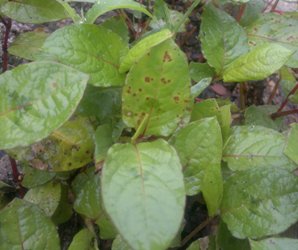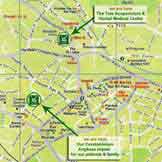Neuro Acupuncture and Ancestral Formula Chinese Herbal Medicine |
|
|
|
|
|
 |
|
Breast Cancer |
Life-threatening-tumors -- that develop in one or both breasts. The interior of the female breast, which consists mostly of fatty and fibrous connective tissues, is divided into about 20 sections called lobes. |
Each lobe is further subdivided into a collection of lobules, which are structures that contain small milk-producing glands. These glands secrete milk into a complex system of tiny ducts. The ducts carry the milk through the breast and converge in a collecting chamber located just below the nipple. Breast cancer is either invasive (spreading) or noninvasive (generally known as in situ , that is, confined to the area of origin). Infiltrating ductal carcinoma, an invasive Cancer, penetrates the wall of a duct, and is the most common form of Breast cancer, constituting about 70% of all cases. Infiltrating lobular carcinoma, an invasive cancer that has spread through the wall of a lobule, accounts for about 8% of all Breast cancers. It is much more likely to appear in both breasts, often in several separate locations. Noninvasive Breast cancers include ductal carcinoma in situ (also called intraductal carcinoma) and lobular carcinoma in situ and account for about 10% of all cases. These cancers are termed noninvasive because at the time of diagnosis there is no evidence of invasion through the basement membrane, a layer separating the affected cells from the underlying connective tissue, which is rich in blood vessels. Ductal carcinoma in situ is considered to be an early malignancy; if left untreated, it may sometimes progress to an invasive, infiltrating ductal Breast cancer. Lobular carcinoma in situ seems to be a marker for an increased risk of cancer in both breasts. In at least 20% of these cases, invasive cancer (often of the ductal variety) eventually develops, sometimes in a different location from the original lobular carcinoma in situ. |
Genetic Factors and Family History |
About 10% of all women with Breast cancer have a family history of the disease. The mutations in genes known as BRCA1 and BRCA2 are now well-known culprits in some early-onset breast and ovarian cancers. About half of BRCA1 carriers have a chance of developing Breast cancer by age 70, and according to one study, about 37% of BRCA2 carriers develop the disease. (These percentages may be higher in high-risk families.) BRCA2 and BRCA1 traits can be passed down to the daughter by either the mother or the father. Only about 0.1% of the population carries them. It should be further noted that a family history of Breast cancer puts a woman at risk for the disease, even if these genetic mutations are not detected. A defective BRCA gene also sometimes appears in no inherited breast and ovarian cancer patients. Cancer may even develop if the normal BRCA1 gene (which is protective) is either under expressed or, in some cases, appears to "hide" outside the nucleus of the cell, where it is ineffective.
Researchers have also identified other defective genes that cause Breast cancer, including BRCA3, p53, and NOEY2 (which is inherited from the father). A mutant gene for the rare disorder ataxia-telangiectasia may account for many Breast cancers. (The disease itself is rare, requiring two copies of the gene, but 1% of the population carries a single copy, which is enough to increase the risk for Breast cancer.) Women who have this gene are also more likely to be harmed by radiation, including that from mammography. |
| |
Over-Exposure to Estrogen |
Because breast tissue is highly sensitive to estrogens, the longer a women is exposed to estrogen over her lifetime, the higher the risk for Breast cancer. In fact, one study reported that blood tests measuring high levels of estrogen and testosterone may eventually identify older women at increased risk for breast cancer.
Early Menstruation and Late Menopause. Women who started menstruation early (before age 12) or went through menopause late (after age 55) are at slightly higher risk, as are those who never had children or had them after the age of 30. Those who has a large breast will have a much higher change of getting the cancer.
Pregnancy and Abortion. Pregnancy plays an odd dual role in Breast cancer. It appears to increase the risk for up to 15 years following the first birth, particularly in older women, but after that women who have given birth have a lower risk than those who have not. Subsequent births do not seem to have any additional impact. Studies have detected an increased risk for Breast cancer in women who have had abortions, possibly because high estrogen levels occur in the first trimester when abortions are most often performed (estrogen levels tend not to be high when a natural miscarriage occurs). The increased risk from abortion is most likely to be very small, however.
Oral Contraception. A small risk for Breast cancer appears to develop in women while taking oral contraceptives and for about 10 years after stopping the Pill.
Hormone Replacement Therapy. A number of studies have indicated an increased risk for Breast cancer in women taking hormone replacement therapy (HRT). Although studies indicate that the risk exists only with long-term therapy, one study reported that even one year of HRT could increase the chances of Breast cancer. Of further concern for women taking HRT, breast tissue density increases and mammograms may miss some Breast cancers. In virtually all studies, however, the real dangers for most women taking HRT are very low. Breast cancers that do occur in women taking hormone replacement therapy also tend to be smaller and less aggressive than most. Some experts argue, however, that the risk of breast cancer from HRT may be underestimated, because until recently women who took HRT tended to be at risk for osteoporosis or heart disease and so were likely to have low estrogen levels. Studies, then, may not yet be reporting the risks for women with normal or high estrogen levels who are now taking HRT to reduce menopausal symptoms or to prevent Alzheimer's disease. Many experts believe that any risk for Breast cancer should be weighed against the other health benefits provided by HRT.
|
| |
Breast Cancer |
A history of proliferate breast disease or atypical cell growth, known as hyperplasia, is a significant risk factor for Breast cancer - Breast Abnormatlities . Benign fibroid tumors may increase risk after many years, particularly if they are complex, such as cysts or if they cause scarring. |
| |
Physical Characteristics |
Studies have reported mixed effects on the association between obesity and Breast cancer. Some suggest that simply being overweight is not a risk factor but that excessive weight gain after menopause is. A number of studies have reported an association between being overweight as a child or young woman and a lower risk for Breast cancer. (Estrogen levels are actually reduced in the presence of high fat levels in premenopausal women.) Women with heavy dense bones are at higher risk for Breast cancer, since estrogen helps build bone mass. There have been reports of a link between increased height and Breast cancer risk, but one controlled study of almost 10,000 women found no association at all. However, women who reached their maximum height at age 18 may have a lower Breast cancer risk than women who reached their full height at 13 or younger -- again probably because they had higher levels of estrogen at an earlier age. |
| |
Environmental Factors |
Exposure to Estrogen-like Chemicals. Chemicals with estrogen-like effects -- called xenoestrogens -- that are found in pesticides and other common industrial products have been suspects for the increased risk of Breast cancer found in specific regions. A number of studies have found no danger to most women from two of the most common environmental estrogens -- PCBs and DDT. Other estrogen-like chemicals that have a stronger association with Breast cancer include dieldrin and beta-hexachlorocyclohexane. Although such chemicals are very weak estrogens, one study stirred alarm by reporting that although exposure to a single weak-estrogen compound poses no risk, combinations of them result in extremely powerful estrogenic chemicals. Many women who took diethylstilbestrol (DES) to prevent miscarriage produced children with abnormal reproductive systems, and there is some indication that it increased the risk for breast cancer in their offspring.
Radiation and Electromagnetic Fields. Heavy exposure to radiation is a significant risk factor for Breast cancer. Women who were treated with high doses of radiation for childhood cancers face a high risk for Breast cancer in adulthood. Studies have been conflicting on increased risks from intensive exposure to electromagnetic fields (EMF). If any risk exists, however, it is likely to be very small.
Reduced Melatonin. Reduced levels of melatonin -- a powerful hormone that affects sleep and other vital functions -- has been associated with Breast cancer. This might account for the higher incidence observed in flight attendants.
|
| |
Please feel free to contact or email us for further details at : |
THE TOLE ACUPUNCTURE & HERBAL MEDICAL CENTRE SDN BHD.
Lot 2.01, 2nd Floor,
Medical Specialist Floor,
Menara KH (Menara Promet),
Jalan Sultan Ismail, 50250 Kuala Lumpur.
Malaysia
Tel No : +603-21418370 / +603-21451671
Whatsapp (only): +6012-7688284
Acupuncture Time : |
| Operating Hours : |
| Monday to Friday : 9:30 am to 7:00 pm |
| Tuesday : 10:00 am to 7:00 pm |
| Saturday : 9:00 am to 6:00 pm |
| Sunday : 12:00 pm to 4:00 pm |
| *(Malaysia Time) |
| |

|
|
|
|
The Tole Officially Opened by our Health Minister. |
|
|
The above picture is taken during the New Medical Centre Opening Ceremony by our Health Minister YAB Dato. Lee Kim Sai in 1993 January 31st. |
|
|
| |
| |
Share us with your friends. |
They may need our assistance! |

LIKE OUR FACEBOOK PAGE! |
| |

FOLLOW OUR TIKTOK PAGE! |
| |

FOLLOW OUR INSTAGRAM PAGE! |
| |
|
| |
Podemos enviar hierbas a tu domicilio mediante: |
|
|
| |
Contact Us |
THE TOLE
Neuro Acupuncture-HERBAL MEDICAL
CENTRE SDN BHD
Lot 2.01, 2nd Floor, Medical Specialist Floor, Menara KH (Menara Promet), Jalan Sultan Ismail, 50250 Kuala Lumpur
Tel: +603-21418370
+603-21451671
Whatsapp (only): +6012-7688284
* E-mail consultation with Master and Assistant.
Ask by e-mail
|
|
|
| |
Accommodation |
|
CONDOMINIUM |
|
| |
|
|
| |
| |
|